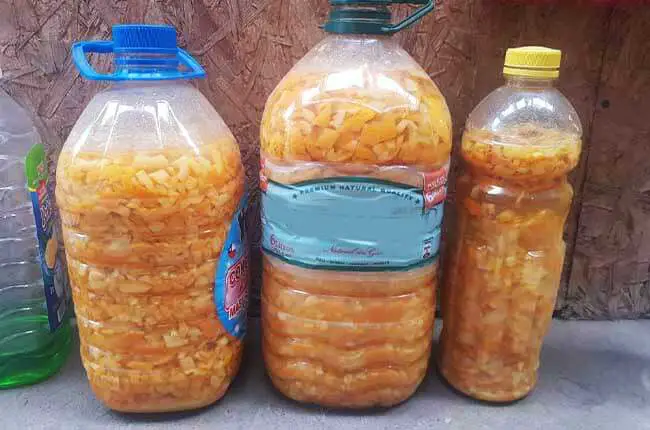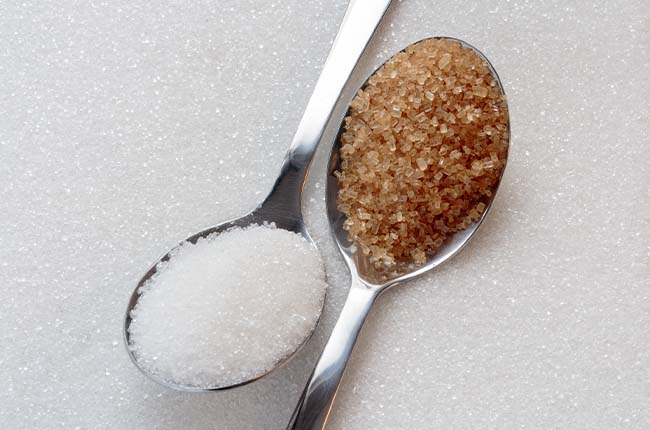People often put molasses or sugar in compost teas to water their organic garden.
Can sugar be really used as a fertilizer?
Sugar feeds the microbes in soil and can be used as a fertilizer to boost the decomposition of organic matter (called the “priming effect”), resulting in the release of more nutrients available for plants. But it is a quick fix because the impact lasts between a few days to a few weeks depending on the organic content in the soil.
In this article, we will look into the science behind why sweetening up the soil can really help fertilize the soil and how to apply it as a fertilizer.
Does sugar feed soil microbes?
Microbes feed on any carbon-containing substances. Since sugar is the most commonly available source of carbon in the biosphere, it is the primary food source for microbes.
Sugar (mainly glucose) plays a crucial role in microbial life by activating dormant microbes. They use the organic carbon in sugar for energy, maintenance, and growth. For this reason, Sugar can function as a “fertilizer” in the soil as it fuels microbial activities which accelerate the conversion of plant nutrients.
Microbes are the main consumers of the sugar in soil. Their speed of taking up simple sugar is very fast, ranging from a few seconds to minutes (Jones & Murphy, 2007). The sugar is then converted into carbon dioxide and released to the atmosphere.
Apart from sugar, they also feed on simple chemical compounds (e.g. nitrites (N), phosphorus (P), potassium (K)) and complex compounds (e.g. lipids, protein).
Natural forms of sugar in soils
In nature, microbes get their sugar naturally from decomposed plant litter in soil, secretions from plant roots, and the sugars released by soil organisms and dead microbes.
1. In plant litter
The major source of sugar for microbes in the soil comes from the decomposed plant matter above ground (e.g. fallen leaves, branches, fruits) and below ground (e.g. dead roots).
Plants produce starch or different forms of sugar in photosynthesis. When they fall on the ground, they are decomposed into a rich source of sugar for microbes.
The plant flesh is mainly simple sugars or monosaccharide or disaccharides. The decomposition of plant flesh is around 70% in 7 months (Cheshire, 1979).
The plant fibers, such as leaves, flowers, branches and roots are mainly polysaccharides. Polysaccharides are complex sugar or a chain of monosaccharides and take much longer to break down or decompose. It can take 3 months to decompose 30% of the plant fibers into sugars, and 2 years to decompose 50-86% (Zech et al., 2012).
| Plant flesh | Plant fibers | |
| Sugars broken down | monosaccharides or disaccharides | polysaccharides |
| Time to decompose | 7 months to decompose 70% | 3 months to decompose 30% years to decompose 50-86% |
2. In root area
Plant roots exude a sweet sugary solution into the soil to feed the colonies of microbes residing in the root zone (rhizosphere). This is done in exchange for the more readily available forms of plant nutrients prepared by the microbes. The plant roots and microbes depend on each other and their relationship is thus known as “symbiotic”.
Studies show that the sugar content in the root exudates is 15-40% of the sugars produced in photosynthesis (Kuzyakov & Domanski, 2000).
And the sugars are mostly glucose (around 40-50%), fructose (23%), saccharose (23%) and ribose (8%).
3. By other soil organisms
Apart from feeding on plant matter, microbes also feed on other microbes and the sugars produced by other organisms in the soil.
Microbes in soil (namely bacteria, actinomyces, fungi) are found to be made of sugars themselves, mostly glucose and mannose (Tanaka et al., 1990).
Other soil organisms also produce sugars. For example, earthworms produce mucus and castings that contain polysaccharides (Guggenberger, Thomas & Zech, 1996). And insects (e.g. plant louse) also contribute to the sugar content in the soil, in small quantities, with their excretions.
How much sugar exists naturally in soil?
The more organic matter there is in the soil, the more sugars there are.
Sugars exist naturally in the soil and is generated in the process of decomposition. The soil consists of different kinds of organic matter, including fresh plant and animal droppings. In the process of decomposing the organic matter in the soil, soil microbes break it down into hummus consisting of smaller organic molecules (e.g. sugars, lipids, and proteins).
Forest soils have the highest quantity of organic matter and sugars in soil, about 2.5 times more than grassland and agricultural land. The concentration of sugars in forest soils is 5 to 130 mg/kg of soil (Hishi et al., 2004).
In very fertile agricultural soil, the concentration is less than 1 ug/g (or 1 mg/kg), which is hard to detect by humans (Panikov, 1995).
Sandy soils have half the sugar content as clay soil (soil with at least 15% clay).
Priming effect of adding sugar to soil
The addition of sugar helps boost microbe numbers and their activity in the decomposition of organic matter in soils (an effect called “sugar priming”). But the benefit only lasts from a few days to a few weeks.
The study of Kuzyakov & Bol (2006) examined the impact of sugar addition on sandy soil poor in organic matter (the “infertile soil”), and on silt/clay soil rich in organic matter content (the “fertile soil”).
It found that the addition of sugar gave an initial boost to the biomass or the number of microbes and boosted the microbial activities in both types of soils in the first few days.
Another study found that the addition of sugar can increase microbial activities by 52% in the soil of a Kivalo birch forest (Karhu et al., 2022).
However, after the added sugar was consumed, the microbial biomass and decomposition activity declined and returned to the initial state after a few days for infertile sandy soil with low organic content, and after a few weeks for fertile slit/clay soil with high organic content.
How to add sugar to the soil?
The most common way of adding sugar to soil is by mixing 1 tbsp of molasses in 1 gallon of water. The reason why many people use molasses (especially blackstrap molasses) is that it contains macro and micronutrients such as Calcium, Iron, and Potassium.
My favorite way of adding sugar to feed the soil is by preparing a fermented sugary citric juice, which combines white sugar (cheaper than molasses) with water and also citric fruit peels.
Recipe
3 parts citric fruit peels (e.g. orange, lemon, grapefruit, pineapple, etc.)
1 part sugar
10 parts water

Preparation
1) Find any unused plastic bottle, preferably with a wide mouth. Measure the height and divide it into 14 parts.
2) Fill 1 part of the height of the bottle with white sugar. Then, put in tap water to fill 10 more parts. The sugar serves to accelerate the decomposition of fruit peels in the fermentation and also functions as fertilizer for the soil later.
3) Chop citrus fruit peels into small parts, big enough that can be put inside the bottle. Cutting the peels is to open up more surfaces of the fruit to ferment naturally. If there are not enough fruit peels to fill 3 more parts in one go, you can put in the chopped peels every day until your bottle fills up.
4) Let the mixture ferment for at least 1 month. Do not screw the lid too close during the first week as the fermentation process generates much gas. The mixture can be kept for at least a year or even longer.
Application
When the mixture is ready, put 1 part of this fermented juice with 100 parts of water to water the garden.
The citric peels can also be mulched into the soil or simply left on top of the soil.
Apply once every week (for sandy soil with low organic content) or once every month (for good clay soil with high organic content).
Benefits for plants
• A well-fermented orange peel concoction has the macronutrients and micronutrients readily available for immediate uptake. For 100g of raw orange peels, there is 1.5g protein (nitrogen), 161mg calcium, 212mg potassium, and 0.8mg iron which are useful nutrients for orchid growth. It also has potassium and phosphorous.
• The fermentation also produces succinic acid and lactic acid for promoting plant growth.
• It is low in pH which most acid-loving plants prefer.
• The citric fruity smell repels gnats and pests.
• The fermented concoction gives off a pleasant smell of fruit juice, rather than a foul rotten smell.
• Fruit peels are easily accessible and it is a great way to recycle kitchen waste.
Conclusion
Sugar can be used as a fertilizer to feed soil microbes because it is their primary food source and has always existed naturally in different forms in the soil. Adding sugar to the soil has a “priming effect” to promote the decomposition of organic matter and the release of more minerals and nutrients for plant uptake.
However, it is a quick fix because the microbial activities return to the previous state after a few days or a few weeks. Watering your garden with a sugary liquid is not a long-term solution to soils with low organic content. Mulching needs to be done to restore soil health.
Nevertheless, it does not hurt to put sugar in the soil. Try out my homemade fermented sugary citric juice recipe – your plants will love the instant boost!
Happy gardening!
Related
Is Vermicompost The Best Fertilizer? (4 Types Compared)
References
Guggenberger, G., Thomas, R.J., Zech, W. (1996). Soil organic matter within earth[1]worm casts of an anecicendogeic tropical pasture community. Applied Soil Ecology 3, 263-274.
Hishi, T., Hirobe, M., Tateno, R. & Takeda, H. (2004). Spatial and temporal patterns of water-extractable organic carbon (WEOC) of surface mineral soil in a cool temperate forest ecosystem. Soil Biology & Biochemistry 36, 1731-1737.
Kuzyakov, Y. & Bol, R. (2006). Sources and mechanisms of priming effect induced in two grassland soils amended with slurry and sugar. Soil Biology & Biochemistry.
Karhu, K., Alaei, S., Li, J. Merilä, P., Ostonen, I. & Bengtson, P. (2022). Microbial carbon use efficiency and priming of soil organic matter mineralization by glucose additions in boreal forest soils with different C:N ratios. Soil Biology and Biochemistry, Vol. 167.
Tanaka, H., Hamada, R., Kondoh, A., Sakagami, K. (1990). Determination of component sugars in soil organic matter by HPLC. Zentralblatt Fur Mikrobiologie, 145, 621-628.
Gunina, A. & Kuzyakov, Y. (2015). Sugars in soil and sweets for microorganisms: Review of origin, content, composition and fate. Soil Biology & Biochemistry, 90, pp.87-100
Hoorman, J. (2010). Understanding Soil Microbes and Nutrient Recycling. Ohio State University
- Keiki Paste vs Rooting Hormone:What’s the difference? - February 4, 2024
- Top 10 Orchid Fertilizers: A Comprehensive Review (2024) - February 2, 2024
- Top 8 Soil Inoculants For Stronger Plants (2024) - February 1, 2024


